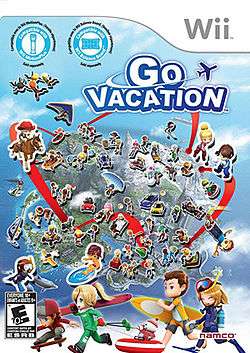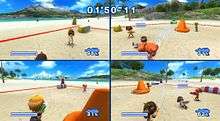Go Vacation
 | |
| Developer(s) | Namco Bandai Games |
|---|---|
| Publisher(s) | |
| Composer(s) | Taku Inoue |
| Platform(s) | Wii |
| Release date(s) | |
| Genre(s) |
Resort tour game Sports |
| Mode(s) | 1–4 players |
Go Vacation (ゴーバケーション Gō Bakēshon) is a variety video game developed and published by Namco Bandai Games for the Wii, as a pseudo-sequel to We Ski and We Ski & Snowboard. In the game, players explore an island containing four paradise resorts and play over 50 mini-games.
Gameplay

In Go Vacation players explore four paradise resorts hosted on Kawawii Island: Marine, City, Mountain, and Snow.[2] Over 50 activities are available on the island including bungee jumping, ice fishing, scuba diving, miniature golf, tennis, off-road racing, and snowman building. The island can be explored at leisure and navigated by walking, rollerblading, or riding on an ATV depending on the resort.[2] The game also holds hidden bonus items, treasure chests, which players may search for while on the island.[2] The game can be played in splitscreen view, with each player having their own view of the game on a single screen.[2] The game is compatible with many of the Wii's accessories including the Wii Balance Board, Wii Zapper, and Wii MotionPlus.[3]
Resorts
The Marine Resort focuses on water-based sports and hosts games such as beach volleyball, surfing, swimming, water gun battles, ATV races, marine bike tricks (an event in which players compete on marine bikes to land different tricks) and scuba diving. The available transport is boat and tour airplane. The available gear is marine bikes and ATV.[4]
The City Resort focuses on extreme and leisure sports and hosts games such as table hockey, a pie throwing game, and a skating game in which players use a skateboard or inline skates to perform stunts or grind on various rails and buildings around the city. The available transport is trolley car. The available gear is inline skates and skateboard.[5]
The Mountain Resort focuses on outdoor activities and includes places to go rafting, kayaking, exploring, off-road car racing and horseback riding. The available transport is the train and boat. The available gear is horses, off-road car and kayak.[6]
The Snow Resort focuses on winter sports and hosts games such as ski jumping, snow tubing, snowboarding, snowmobiling, and snowball fighting. The available transport is chairlifts and helicopters. The available gear is skis, snowboard, snowmobile and snowtube.[7]
Development
Go Vacation was first shown at Namco Bandai's booth at E3 2011, a video game trade show held in downtown Los Angeles.[2] After viewing a trailer for the game, GameSetWatch noted that the game appeared to be a "quality title" and favorably compared it to Wii Sports Resort, a similar variety game. The game has noticeable Pac-Man references.[8]
Music
The Go Vacation soundtrack consists of a wide range of instrumental and vocal tracks from composers, musicians, and vocal artists including Taku Inoue, Norihiko Hibino, Nobuyuki Ohnogi, Aubrey Ashburn, and Jody Whitesides.[9][10] On December 21, 2012, Japanese record label Sweep Records released the officially licensed album of songs containing live instrumentation and vocals, Namco Music Saloon. This album and aspect of the game's soundtrack consists of original arrangements of classic tunes from Namco titles including Ridge Racer, Dig Dug, Pac-Man, New Rally-X, and Kotoba no Puzzle: Mojipittan.[11] On March 23, 2013 Namco Bandai released the remaining, original background music, GO VACATION BGM Album, directly through its Namco Sounds label on iTunes.[12]
Reception
| Reception | ||||||||||||||||||||||||||||||
|---|---|---|---|---|---|---|---|---|---|---|---|---|---|---|---|---|---|---|---|---|---|---|---|---|---|---|---|---|---|---|
| ||||||||||||||||||||||||||||||
The game received "mixed" reviews according to the review aggregation website Metacritic.[13] In Japan, Famitsu gave it a score of one eight and three sevens for a total of 29 out of 40.[15]
Sales
Go Vacation sold 47,209 copies in its first week on sale in Japan, being the third most popular game that week behind other new releases Macross F: The Wings of Goodbye Hybrid Pack and Naruto Shippuden: Ultimate Ninja Impact.[24]
References
- ↑ Daniel Vuckovic (20 October 2011). "Nintendo Australia outlines Wii and DS line-up for the rest of 2011". Vooks. Retrieved 28 June 2016.
- 1 2 3 4 5 Justin Calvert (8 June 2011). "E3 2011: Go Vacation Hands-On Preview". GameSpot. Retrieved 28 June 2016.
- ↑ William Usher (23 September 2011). "Go Vacation Official Release Date Set For Wii". CinemaBlend. Retrieved 27 September 2011.
- ↑ "Go Vacation: Marine Area". Bandai Namco Entertainment. Archived from the original on 26 September 2011. Retrieved 28 June 2016.
- ↑ "Go Vacation: City Area". Bandai Namco Entertainment. Archived from the original on 5 October 2011. Retrieved 28 June 2016.
- ↑ "Go Vacation: Mountain Area". Bandai Namco Entertainment. Archived from the original on 7 October 2011. Retrieved 28 June 2016.
- ↑ "Go Vacation: Snow Area". Bandai Namco Entertainment. Archived from the original on 7 October 2011. Retrieved 28 June 2016.
- ↑ Eric Caoili (19 July 2011). "To Everyone's Amazement, Go Vacation Looks Kind Of Awesome". GameSetWatch. UBM TechWeb. Retrieved 15 September 2011.
- ↑ "Namco Music Saloon ~ from GO VACATION". VGMDb. Retrieved 18 September 2013.
- ↑ "Interview with Taku Inoue (October 2012)". Square Enix Music. Archived from the original on 10 December 2013. Retrieved 28 June 2016.
- ↑ "Namco Music Saloon -From Go Vacation-". Video Game Music Online. Retrieved 28 May 2015.
- ↑ "GO VACATION BGM Album". iTunes. Retrieved 18 September 2013.
- 1 2 "Go Vacation for Wii Reviews". Metacritic. Retrieved 28 June 2016.
- ↑ Jim Sterling (13 October 2011). "Review: Go Vacation". Destructoid. Retrieved 28 June 2016.
- 1 2 Brian (11 October 2011). "Famitsu review scores (10/11)". Nintendo Everything. Retrieved 28 June 2016.
- ↑ "Go Vacation". GamesMaster: 94. 25 December 2011.
- ↑ Chris Watters (18 October 2011). "Go Vacation Review". GameSpot. Retrieved 28 June 2016.
- ↑ Audrey Drake (13 October 2011). "Go Vacation Review". IGN. Retrieved 28 June 2016.
- ↑ "Go Vacation". Nintendo Gamer: 60. November 2011.
- ↑ Mark Reece (11 November 2011). "Review: Go Vacation". Nintendo Life. Retrieved 28 June 2016.
- ↑ "Go Vacation". Nintendo Power. 273: 77. November 2011.
- ↑ Jared Rosenberg (28 October 2011). "Go Vacation". Nintendo World Report. Retrieved 28 June 2016.
- ↑ Chris Scullion (4 November 2011). "Go Vacation Review". Official Nintendo Magazine. Archived from the original on 7 October 2014. Retrieved 28 June 2016.
- ↑ Ishaan (26 October 2011). "This Week In Sales: It Was A Namco Bandai Week". Siliconera. Retrieved 28 October 2011.
External links
- Official website (US)
- Official website (Japan)